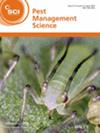求助PDF
{"title":"2,4-D 在植物体内的代谢:耐受性作物和抗性杂草代谢解毒途径的比较分析。","authors":"Joel Torra, Ricardo Alcántara-de la Cruz, Marcelo Rodrigues Alves de Figueiredo, Todd A Gaines, Mithila Jugulam, Aldo Merotto, Candelario Palma-Bautista, Antonia M Rojano-Delgado, Dean E Riechers","doi":"10.1002/ps.8373","DOIUrl":null,"url":null,"abstract":"<p><p>The commercialization of 2,4-D (2,4-dichlorophenoxyacetic acid) latifolicide in 1945 marked the beginning of the selective herbicide market, with this active ingredient playing a pivotal role among commercial herbicides due to the natural tolerance of monocots compared with dicots. Due to its intricate mode of action, involving interactions within endogenous auxin signaling networks, 2,4-D was initially considered a low-risk herbicide to evolve weed resistance. However, the intensification of 2,4-D use has contributed to the emergence of 2,4-D-resistant broadleaf weeds, challenging earlier beliefs. This review explores 2,4-D tolerance in crops and evolved resistance in weeds, emphasizing an in-depth understanding of 2,4-D metabolic detoxification. Nine confirmed 2,4-D-resistant weed species, driven by rapid metabolism, highlight cytochrome P450 monooxygenases in Phase I and glycosyltransferases in Phase II as key enzymes. Resistance to 2,4-D may also involve impaired translocation associated with mutations in auxin/indole-3-acetic acid (Aux/IAA) co-receptor genes. Moreover, temperature variations affect 2,4-D efficacy, with high temperatures increasing herbicide metabolism rates and reducing weed control, while drought stress did not affect 2,4-D efficacy. Research on 2,4-D resistance has primarily focused on non-target-site resistance (NTSR) mechanisms, including 2,4-D metabolic detoxification, with limited exploration of the inheritance and genetic basis underlying these traits. Resistance to 2,4-D in weeds is typically governed by a single gene, either dominant or incompletely dominant, raising questions about gain-of-function or loss-of-function mutations that confer resistance. Future research should unravel the physiological and molecular-genetic basis of 2,4-D NTSR, exploring potential cross-resistance patterns and assessing fitness costs that may affect future evolution of auxin-resistant weeds. © 2024 Society of Chemical Industry.</p>","PeriodicalId":218,"journal":{"name":"Pest Management Science","volume":null,"pages":null},"PeriodicalIF":3.8000,"publicationDate":"2024-08-12","publicationTypes":"Journal Article","fieldsOfStudy":null,"isOpenAccess":false,"openAccessPdf":"","citationCount":"0","resultStr":"{\"title\":\"Metabolism of 2,4-D in plants: comparative analysis of metabolic detoxification pathways in tolerant crops and resistant weeds.\",\"authors\":\"Joel Torra, Ricardo Alcántara-de la Cruz, Marcelo Rodrigues Alves de Figueiredo, Todd A Gaines, Mithila Jugulam, Aldo Merotto, Candelario Palma-Bautista, Antonia M Rojano-Delgado, Dean E Riechers\",\"doi\":\"10.1002/ps.8373\",\"DOIUrl\":null,\"url\":null,\"abstract\":\"<p><p>The commercialization of 2,4-D (2,4-dichlorophenoxyacetic acid) latifolicide in 1945 marked the beginning of the selective herbicide market, with this active ingredient playing a pivotal role among commercial herbicides due to the natural tolerance of monocots compared with dicots. Due to its intricate mode of action, involving interactions within endogenous auxin signaling networks, 2,4-D was initially considered a low-risk herbicide to evolve weed resistance. However, the intensification of 2,4-D use has contributed to the emergence of 2,4-D-resistant broadleaf weeds, challenging earlier beliefs. This review explores 2,4-D tolerance in crops and evolved resistance in weeds, emphasizing an in-depth understanding of 2,4-D metabolic detoxification. Nine confirmed 2,4-D-resistant weed species, driven by rapid metabolism, highlight cytochrome P450 monooxygenases in Phase I and glycosyltransferases in Phase II as key enzymes. Resistance to 2,4-D may also involve impaired translocation associated with mutations in auxin/indole-3-acetic acid (Aux/IAA) co-receptor genes. Moreover, temperature variations affect 2,4-D efficacy, with high temperatures increasing herbicide metabolism rates and reducing weed control, while drought stress did not affect 2,4-D efficacy. Research on 2,4-D resistance has primarily focused on non-target-site resistance (NTSR) mechanisms, including 2,4-D metabolic detoxification, with limited exploration of the inheritance and genetic basis underlying these traits. Resistance to 2,4-D in weeds is typically governed by a single gene, either dominant or incompletely dominant, raising questions about gain-of-function or loss-of-function mutations that confer resistance. Future research should unravel the physiological and molecular-genetic basis of 2,4-D NTSR, exploring potential cross-resistance patterns and assessing fitness costs that may affect future evolution of auxin-resistant weeds. © 2024 Society of Chemical Industry.</p>\",\"PeriodicalId\":218,\"journal\":{\"name\":\"Pest Management Science\",\"volume\":null,\"pages\":null},\"PeriodicalIF\":3.8000,\"publicationDate\":\"2024-08-12\",\"publicationTypes\":\"Journal Article\",\"fieldsOfStudy\":null,\"isOpenAccess\":false,\"openAccessPdf\":\"\",\"citationCount\":\"0\",\"resultStr\":null,\"platform\":\"Semanticscholar\",\"paperid\":null,\"PeriodicalName\":\"Pest Management Science\",\"FirstCategoryId\":\"97\",\"ListUrlMain\":\"https://doi.org/10.1002/ps.8373\",\"RegionNum\":1,\"RegionCategory\":\"农林科学\",\"ArticlePicture\":[],\"TitleCN\":null,\"AbstractTextCN\":null,\"PMCID\":null,\"EPubDate\":\"\",\"PubModel\":\"\",\"JCR\":\"Q1\",\"JCRName\":\"AGRONOMY\",\"Score\":null,\"Total\":0}","platform":"Semanticscholar","paperid":null,"PeriodicalName":"Pest Management Science","FirstCategoryId":"97","ListUrlMain":"https://doi.org/10.1002/ps.8373","RegionNum":1,"RegionCategory":"农林科学","ArticlePicture":[],"TitleCN":null,"AbstractTextCN":null,"PMCID":null,"EPubDate":"","PubModel":"","JCR":"Q1","JCRName":"AGRONOMY","Score":null,"Total":0}
引用次数: 0
引用
批量引用


